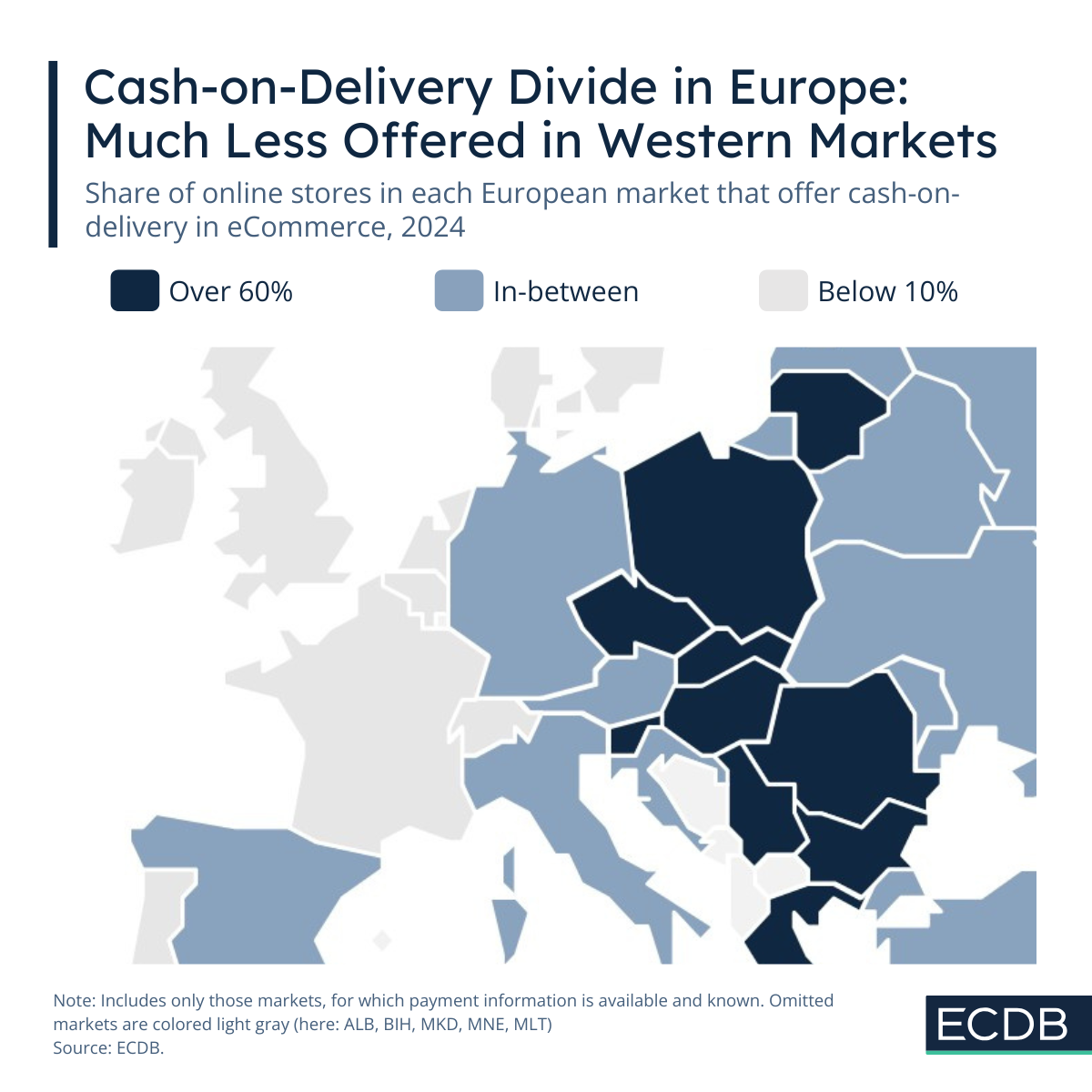China and the U.S. Digitally Minded in Payment: E-Wallets, PayPal, AliPay
PayPal belongs to the pioneers of eWallets as we know them today. Other fintech companies, powered by the biggest in tech, have now caught up.
Payments in eCommerce
Scandinavia and Northern Europe use cash payments in eCommerce rarely. How this division comes about.

Nadine Koutsou-Wehling
Data Journalist
June 03, 2025
Payment

The payment landscape of an eCommerce region can give insight into the overall state of eCommerce. Different payment distribution leads to different conclusions: A high share of e-wallets typically points to mature digitalization and high consumer trust in new tech. Other payment options not so much.
We looked at the penetration of Cash on Delivery (CoD) across Europe’s eCommerce scene. A look at the ensuing distribution map shows that there is a clear divide between West and East: CoD is barely a thing in the Western part of the continent, while it is highly significant on the other side.
Displaying the share of online stores that offer CoD in each eCommerce market in Europe, three categories emerge: The ones where over 60% of online stores in the market offer cash payments on delivery, the ones where less than 10% offer CoD, and the ones in between.
An unmistakable pattern shows how Scandinavian and Western to Northern European markets tend to offer CoD at a percentage below 10% in eCommerce. Given the generally high penetration of card payments in everyday life outside eCommerce in markets like Sweden, Norway, and the UK, CoD has an even smaller significance in online shopping.
This is further underlined by the fact that modern payment services like Klarna originated in Scandinavia: Digitally organizing finances to manage liquidity contrasts the physical nature of cash payments.
Consumers in the United Kingdom are prone to using credit cards or e-wallets in eCommerce, which account for the top 5 payment methods in UK eCommerce: Mastercard, VISA, American Express, PayPal and Apple Pay. The self-evidence with which online payments are used on a broad scale makes CoD outdated in most cases.
On the other end of the spectrum are the markets with a CoD penetration over 60%. They are unanimously located on the Eastern side of the continent, which indicates common consumer preferences, infrastructural conditions and provider diversity.
Poland barely scrapes the 60.0% mark, with a CoD penetration of 60.7% in the online market. 64.9% of online stores in Lithuania offer CoD, while cash payments in eCommerce are more common in Serbia, with 69.2%.
But the clear winner in terms of CoD penetration in Europe is Greece, where 85.6% of online stores offer consumers to pay by cash on delivery. Only Bulgaria and Slovakia approach this value, with similar percentages of 80.3% and 80.1%, respectively. The economic landscape favors cash payments, given past crises, which is why in certain markets this preference goes into eCommerce.
Besides the requirements of digital connectivity of online stores and the regulatory framework that goes along with it, CoD penetration is a matter of delivery preference. Because CoD payments are given priority by Greek courier companies to collect the cash and receive their pay accordingly, shoppers prefer the speed of delivery and the safety that goes with only paying for what they have collected.
For the remaining markets in between the highest and lowest ranges, CoD penetration is declining. Fewer and fewer stores offer cash on delivery, as the range of cards and digital payment providers grow. Increasing connectivity of eCommerce within Europe and with international sellers and platforms contribute to a diminishing allure of CoD.
Related Articles
PayPal belongs to the pioneers of eWallets as we know them today. Other fintech companies, powered by the biggest in tech, have now caught up.
PayPal is most offered by online stores in Germany, in the U.S. not so much. The e-wallet performs best in Europe, overall.
While the number of payment options offered varies from country to country, so too does the diversity of payment methods. In the field of payments, two methods can be found again and again: Mastercard & VISA.

Click here for
more relevant insights from
our partner Mastercard.
Our Tool
We’re not just another blog—we’re an advanced eCommerce data analytics tool. The insights you find here are powered by real data from our platform, providing you with a fact-based perspective on market trends, store performance, industry developments, and more.
Analyze retailers in depth with our extensive Retailer dashboards and compare up to four retailers of your choice.
Learn More
Combine countries and categories of your choice and analyze markets in depth with our advanced market dashboards.
Learn More
Compile detailed rankings by category and country and fine-tune them with our advanced filter options.
Learn More
Discover relevant leads and contacts in your chosen markets, build lists, and download them effortlessly with a single click.
Learn More
Benchmark transactional and conversion funnel KPIs against market standards and gain insight into the key metrics of your relevant market.
Learn More
Our reports provide pre-analysed data and highlight key insights to help you quickly identify key trends.
Learn More
Find your perfect solution and let ECDB empower your eCommerce success.